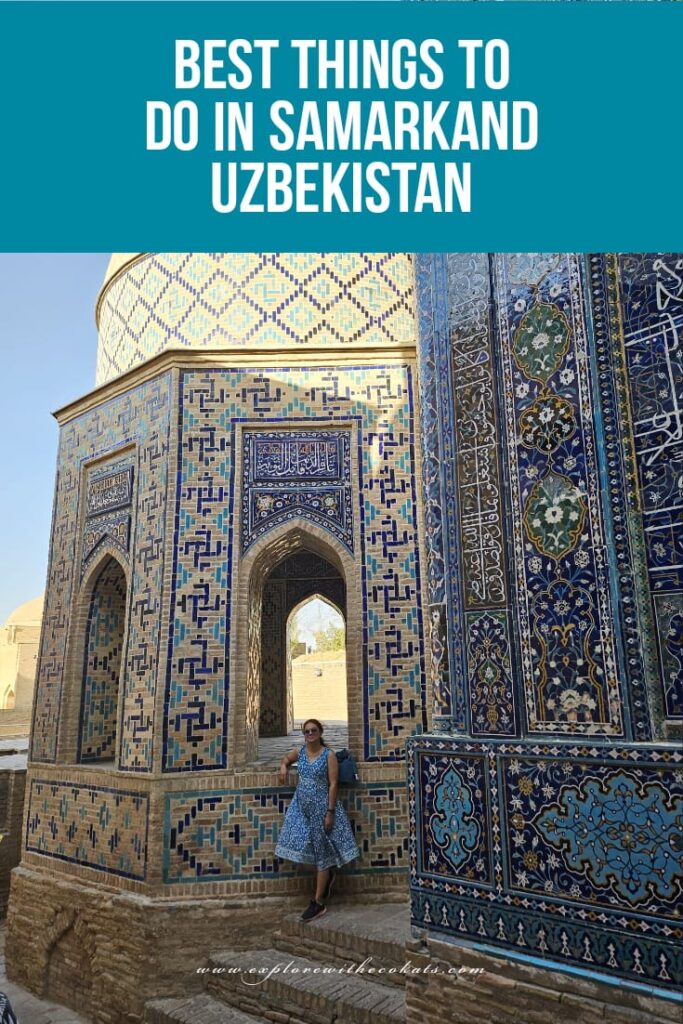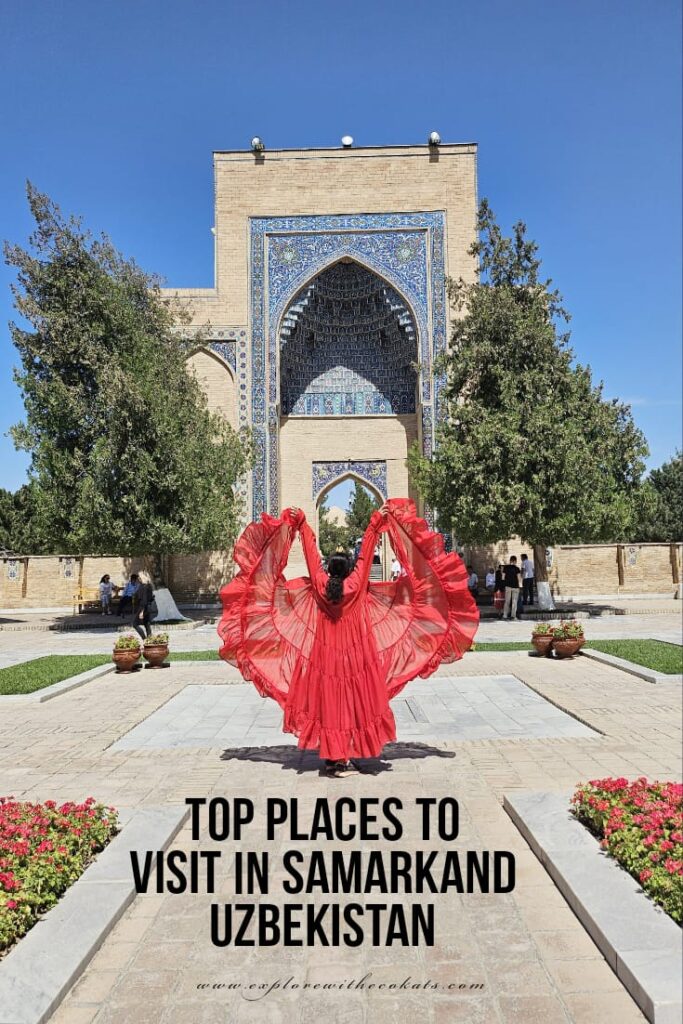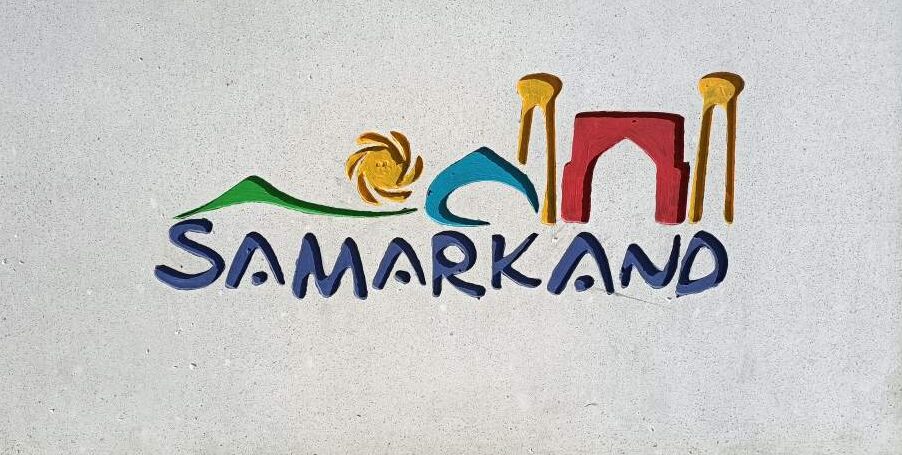Last Updated on May 17, 2024 by
This complete city guide to Samarkand attractions covers things to do in Samarkand, places to visit in Samarkand, Samarkand itinerary, where to eat in Samarkand, where to shop in Samarkand as well as travel tips.
Samarkand is Uzbekistan‘s second largest city, and is famous for being one of the most important Silk Road cities. It is also one of the oldest cities in the world, founded around the 7th century BC.
If someone asked me about my favorite city in Uzbekistan that offers stunning architecture of mosques and mausoleums, has an amazing city vibe and also vibrant bazaars, it would be Samarkand. I loved my visit to Tashkent, Bukhara and Khiva, but Samarkand stole the show and how!
No wonder, poets and historians have described Samarkand as “The Pearl of the Eastern Muslim World”.
Table of Contents
HISTORY OF SAMARKAND
Samarkand served as the capital of both the ancient Sogdian empire and the Timurid empire under Timur the Great (Tamerlane). Timur ascended to power in the late 14th century, and his empire extended from present-day Turkey and Iran to India. Despite Timur’s reputation as a formidable military leader, he displayed a profound interest in art, culture, and architecture.
Under Timur’s influence, Samarkand evolved into a hub of arts and Islamic education. He generously supported scholars, artists, and architects, giving rise to the distinctive Timurid architectural style.
Samarkand earned a reputation as one of the most enchanting cities in Central Asia. However, its golden era came to an end in 1500 when Uzbek nomadic warriors seized control, relocating the capital to Bukhara.
As a consequence, Samarkand experienced a decline, leading to the deterioration of its mausoleums, mosques, and madrassas. The city’s revival only occurred with the intervention of the Soviets, who linked Samarkand to the Trans Caspian railway and undertook the restoration of numerous Timurid monuments.
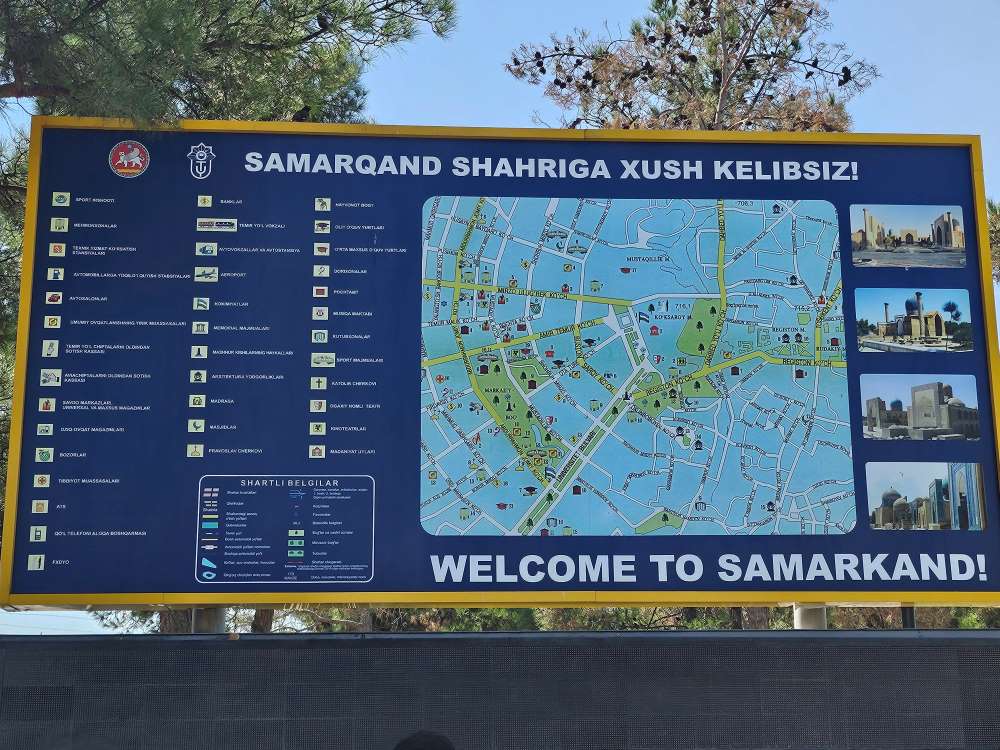
PRACTICAL TIPS FOR PLACES TO VISIT IN SAMARKAND
Getting to Samarkand
Samarkand is very well connected to Tashkent which is generally the first destination by international travelers in Uzbekistan. It is also very well connected to Bukhara. There are several trains each day from Tashkent and Bukhara to Samarkand. They are fast, comfortable, and generally run-on schedule. The trip from Tashkent to Samarkand takes less than three hours in Afrosiyob (bullet train) and less than two hours from Bukhara to Samarkand in Afrosiyob (bullet train).
The Samarkand International Airport also services many foreign destinations such as Moscow, Kuwait, Warsaw, Dubai, Abu Dhabi, Istanbul, etc. The distance from the airport to the center of Samarkand is 8 km and one can get to any point of the city both by taxi and by city buses.
Getting around Samarkand
Tourists can use local taxis or app-based taxis – YandexGo. Similar to Uber, it is widely used in Uzbekistan. This is really useful as you don’t have to haggle with the taxi drivers regarding the fares and confusion regarding the destination – the accent makes it difficult to understand. An average taxi ride from anywhere in Samarkand is approximately 12,000 – 20,000 UZS ($1 – 1.6)
Samarkand also has yellow taxis operating on a shared taxi system meaning they will continue to pick up additional people as long as there are extra seats. There is a flat rate of 4,000 UZS ($0.32) for most trips around downtown and Registan.
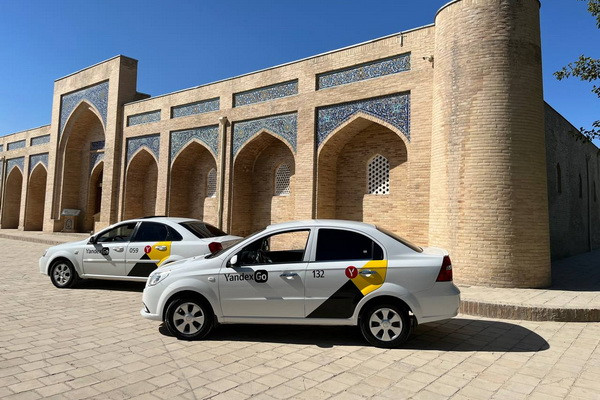
Where to stay in Samarkand
Registan Hostel
Located very close to the Registan Square, Registan Hostel has air conditioned dorms and private rooms. It also features complimentary WiFi access and a common lounge, shared kitchen and airport transfers.
The property can be booked here.
Muborak Hostel/Homestay
A family run hostel, it has the feel of a guest house or AirBnB. It is 1 km from Bibi Khanum Mosque and can be easily reached by a short walk.
The rooms are clean and comfortable at Muborak Hostel. And the food buffet at breakfast and dinner is incredible too. The owner has a convenience store that sells baked goods (including Uzbek bread), snacks, water, cold drinks, etc.
Muborak Hostel can be booked here.
Orient Star Hotel
The hotel features an outdoor swimming pool and poolside terrace that is located in the old part of the city. Orient Star Samarkand’s rooms include a minibar, TV and wi-fi. Breakfast is provided in the hotel’s restaurant, which serves both European and regional Uzbek cuisine.
Orient Star Hotel can be booked here.
Where to eat in Samarkand
Being a vegetarian, I was quite worried about getting vegetarian food in Uzbekistan. Thankfully, Samarkand has vegetarian food options across the city.
These are some of the vegetarian restaurants in Samarkand that I tried and liked.
Mone Cafe & Bakery
Mone Cafe is a modern resto-café with a menu that contains multiple vegetarian and vegan items. Items include salads, sides, breads, and fruit platters for dessert.
Address: 32A Bobur Mirzo Str, Samarkand
Samarkand Art House Cafe
Located right next to Bibi-Khanum Mosque, I stumbled across a large sign outside advertising a vegetarian menu. The restaurant also houses an arts & crafts shop that supports disadvantaged children when you purchase something.
The restaurant has set up tables on a veranda and a few in the garden with a view of the mosque. It offers a good variety of vegetarian items that are vegan or can be made vegan. The tea collection is also nice and the quantity of drinks and food is good.
Address: MX5J+W4W, Samarkand
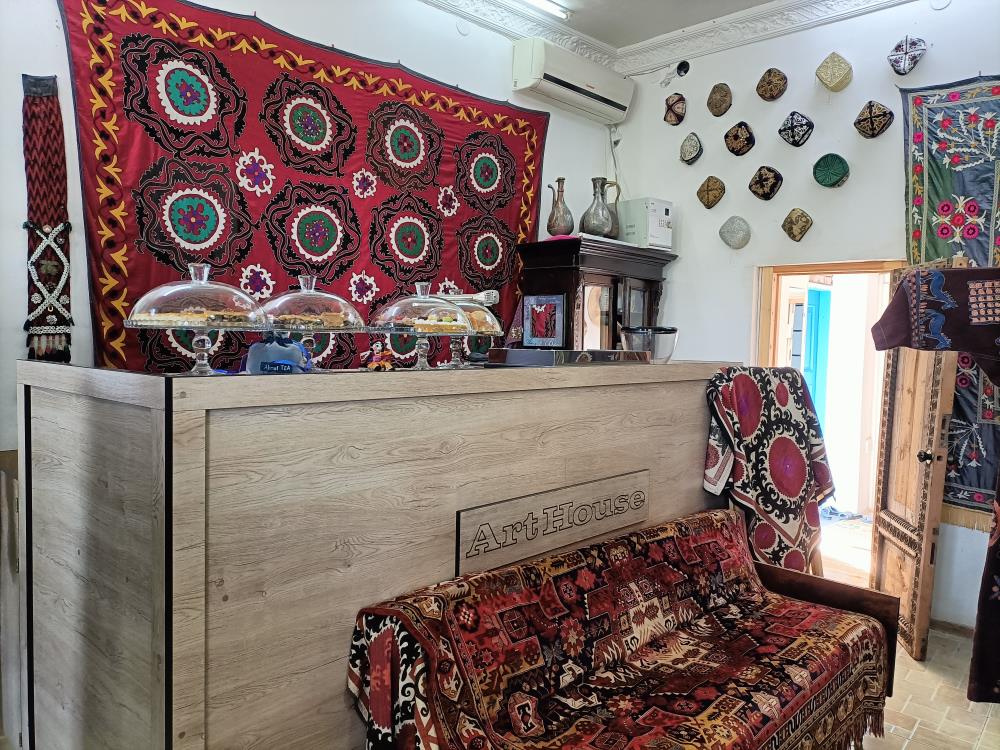
3 DAYS SAMARKAND ITINERARY
I took the 9:45 am Afrosiyob from Tashkent and reached Samarkand at 11:15am. I checked-in to my homestay and had lunch. I was ready to move out by 2pm but it was extremely hot. So, I ventured out at 4pm.
I walked through inner-city roads from my homestay and reached a big wooden door. One side of the door was open and on peeping on the other side, it was such a contrast. Known as Tashkent Road or Islom Karimov Street, this road was pedestrian friendly with fancy boulevard and cafes & shops lined on both sides and an amazing vibe. I’m giving this information because everything is walking distance from here.
Day 1 (second half):
- Explore Tashkent Street
- Bibi Khanym Mosque
- Registan Night Show
Day 2:
- Registan
- Gur-i-Amir
- Shah-i-Zinda
Day 3:
- Ulugbeg’s Observatory
- Konigil village and Meros Paper Mill
- Shopping at Siyob Bazaar
- Leave at 9 pm to Bukhara on Afrosiyob
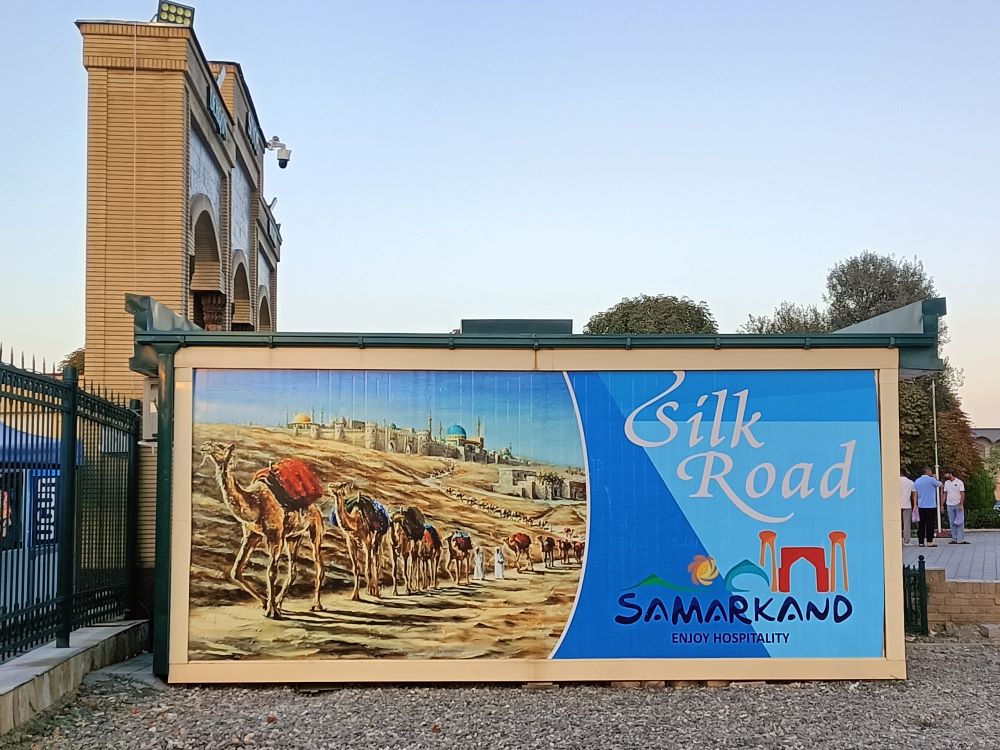
THINGS TO DO IN SAMARKAND, UZBEKISTAN
Explore Registan
The first place to visit in Samarkand is the grand ‘Registan’.
Registan is a big square with 3 majestic and distinctive madrasas (Islamic schools) – adorned with azure mosaics, beautiful arches, open backyards and vast, well-proportioned spaces.
The Registan, which translates to ‘Sandy Place’ in Tajik, was a public square, where people gathered to hear royal proclamations, heralded by blasts on enormous copper pipes called dzharchis — and a place of public executions. In the medieval period it was Samarkand’s commercial center.
The madrasas now stand there inviting tourists to glare at their beautiful designs. Each madrasa has something intriguing inside them to keep the tourist glued!
Tilya-Kori is the central madrasa. The two other madrasa in Registan are the Sherdor Madrasa on the right, and the Ulugbek Madrasa on the left. Both have beautiful courtyards in the back with small rooms which are now turned into souvenir shops.
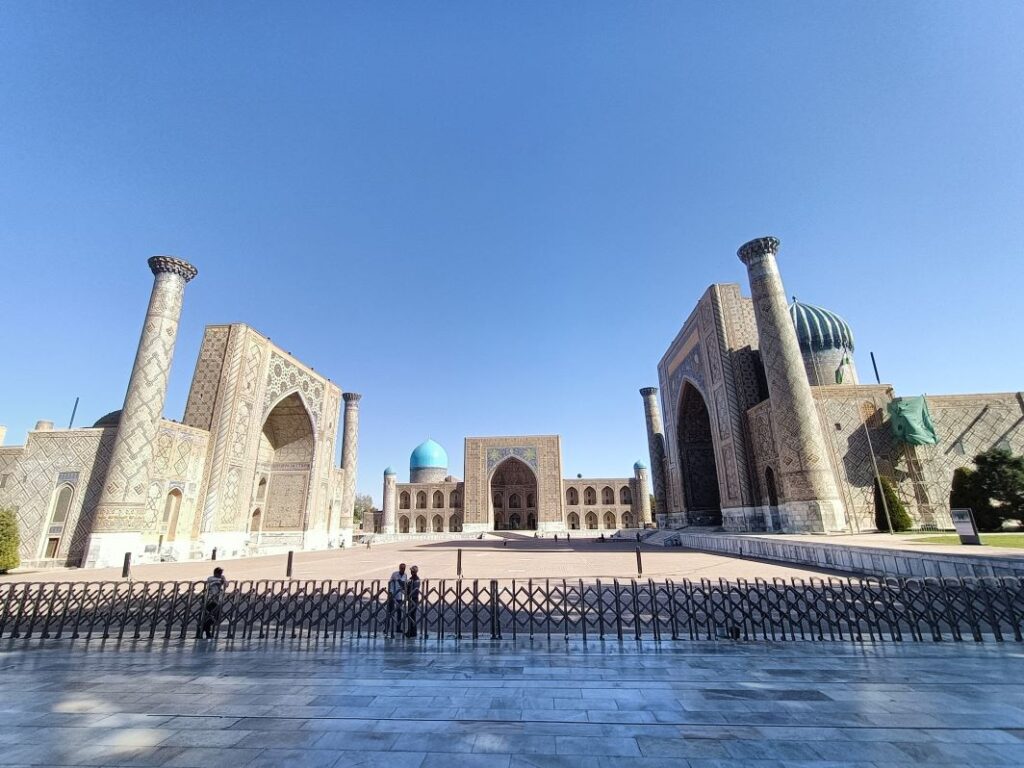
Tilya-Kori Madrasa
In Uzbek, Tilya-Kori means “gilded”. It is the newest of the three madrasas in Registan Square.
It has the most striking interior area with a small mosque. The walls of the mosque are covered in intricate gold details and the ceiling is spectacular. It also has a small exhibition area where photos of Registan before restoration are displayed.
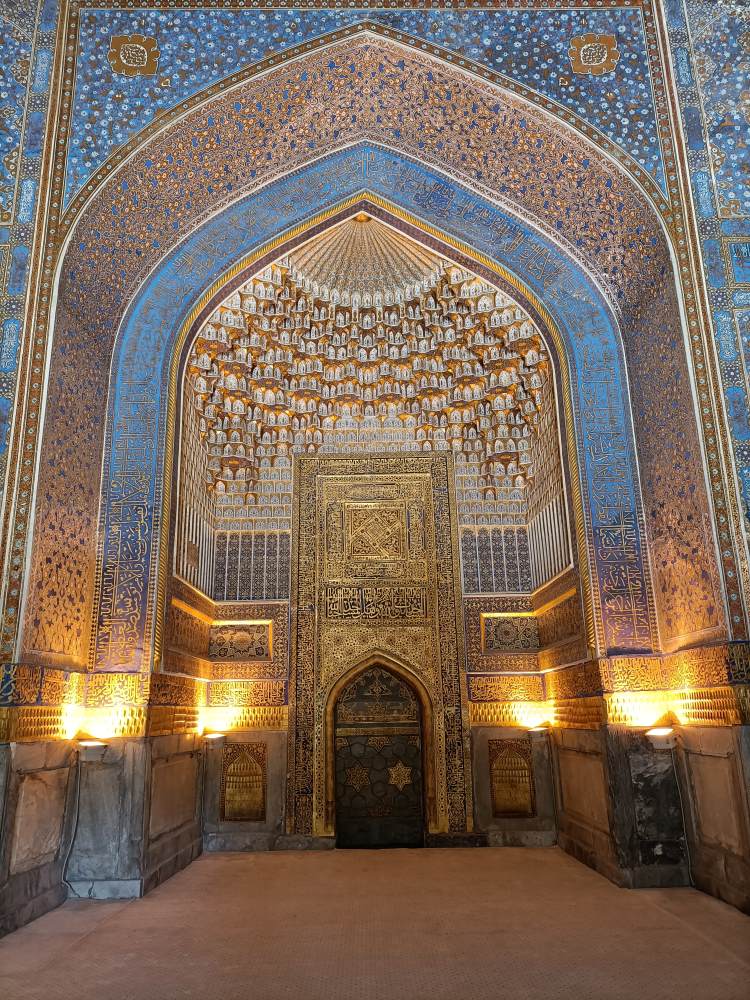
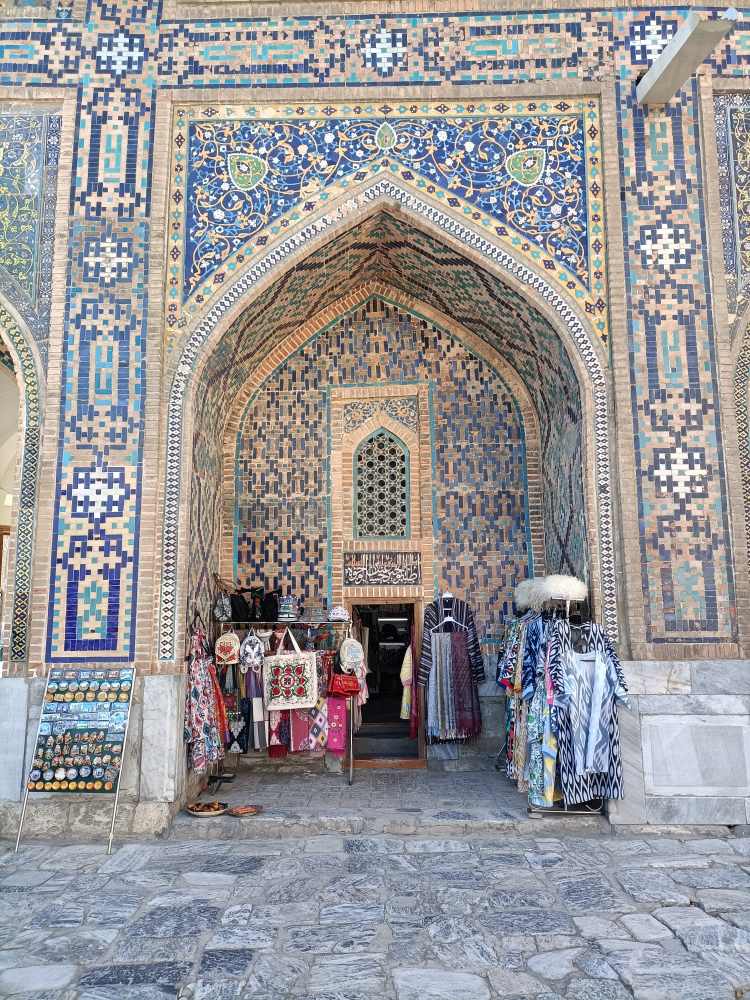
Ulugbek Madrasa
The oldest madrasa in Registan Square, Ulugbek Madrasa was built during the 15th century and quickly became a hub for Islamic scholarship, attracting some of the brightest minds of its time. It served as an educational institution where students learned about subjects ranging from theology and mathematics to astronomy and philosophy.
The madrasa played a pivotal role in advancing knowledge in various fields, and Ulugbek himself was a celebrated astronomer whose astronomical observations led to significant discoveries.
Inside the madrasa, visitors can explore the Ulugbek Museum, which is dedicated to the life and contributions of Ulugbek, who was not only a ruler but also a pioneering scientist. The museum houses a fascinating collection of astronomical instruments, manuscripts, and exhibits that showcase Ulugbek’s revolutionary work in astronomy.
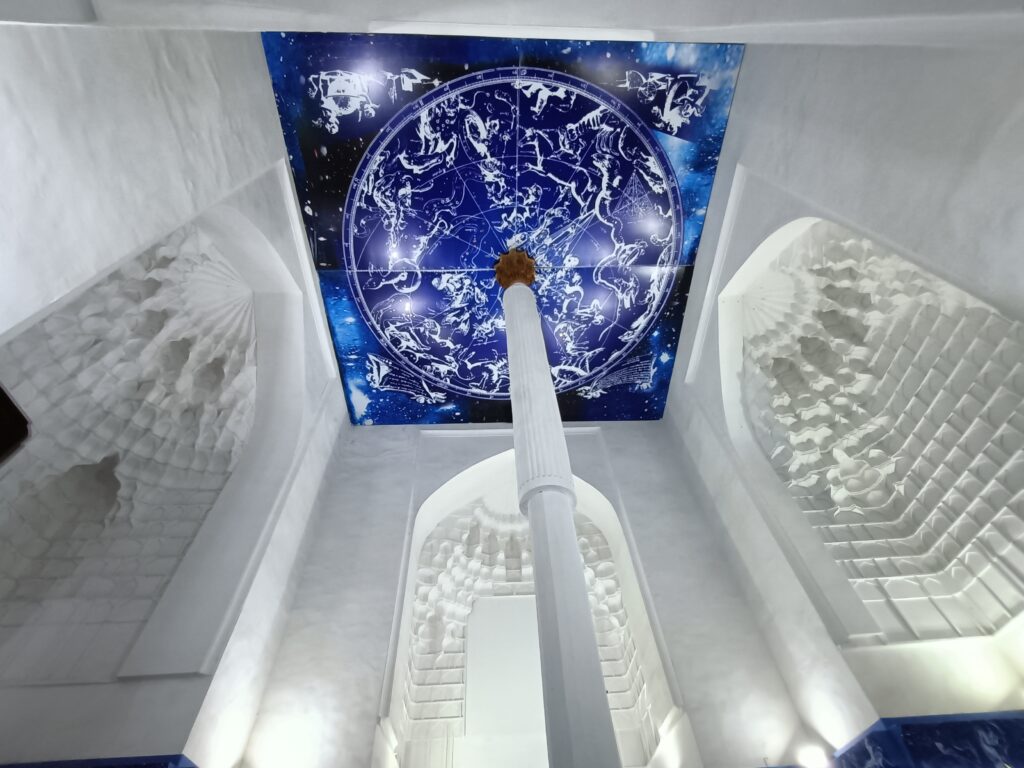
Sherdor Madrasa
In Uzbek, Sherdor means “with lions”. The madrasa was constructed during the 17th century, under the reign of Yalangtush Bahadur, a descendant of the famous conqueror Tamerlane. This madrasa has a design that combines elements of Islamic architecture with Central Asian aesthetics. Its most striking feature is the twin tiger mosaics that flank the main portal.
There is an option of dressing up as a local at the Sherdor Madrasa where tourists can rent a traditional Uzbek outfit for the small fee of 5,000 UZS per person.
Registan Square Entry Fees: 50,000 UZS ($4)
Registan Square Timings: Open daily from April to October from 8 am to 7 pm and from November to March from 9 am until 5 pm.
Note: The entrance ticket is valid all day long, allowing you to come back at sunset and photograph the complex at various times of day depending upon the sunlight direction. Tell the complex security guards if you’d like to reuse the ticket, otherwise they will tear your ticket and you won’t be able to reuse it.
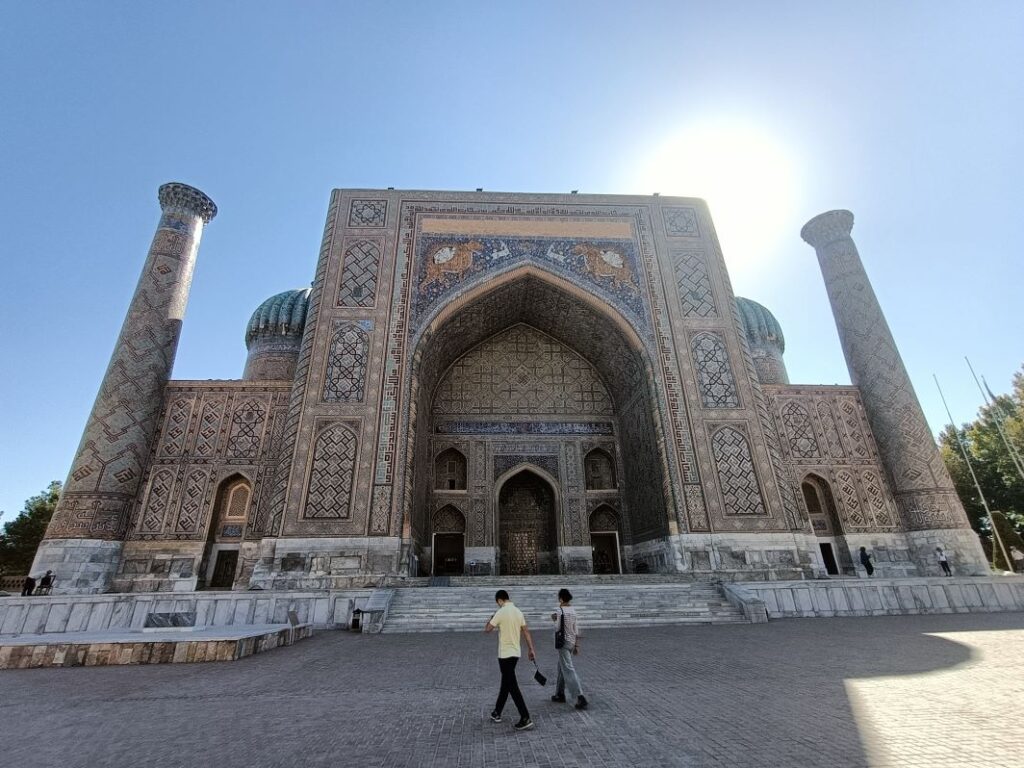
Attend the Registan Square Light Show
After sunset, all the three madrasa are lit up and look extremely beautiful. It is important to visit Registan square both in the day and night for this reason.
There is a Registan Square Light show at 9 pm daily where traditional music is played and lights dance on the madarasa. It is breathtaking. The Registan Light Show is free and there are steps where one can sit and enjoy the show.
Watching the night show from the inner court is also possible, but one needs to buy a ticket again. The cost is 60,000 UZS per person ($4.79).
I did not want to buy a ticket again and it was still amazing to watch it from the outer area.
Entrance Fees to Registan Square Light Show: Free
Registan Square Light Show Timings: 9pm – 10 pm
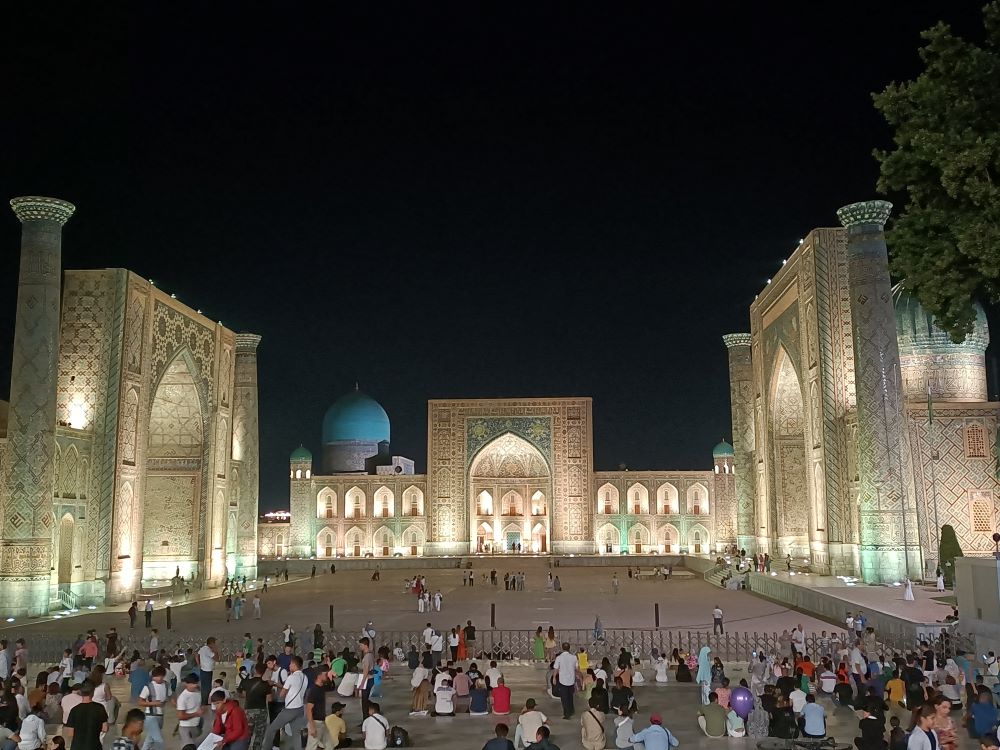
Visit the Bibi-Khanym Mosque
Named after the wife of Timur the Great, Bibi Khanym Mosque was built by Amir Timur himself and he wanted to make it into the most magnificent mosque of the Islamic world. However, Timur got a bit too ambitious and pushed the building techniques to their limit. Due to the push structural problems were encountered and the mosque slowly started to deteriorate until an earthquake in 1897 left the building in ruins.
Bibi-Khanym Mosque is one of the looked forward attractions in Samarkand. Located on Tashkent Street in front of the Siyob Bazaar, the mosque has a beautiful courtyard. It was undergoing restoration when I visited so some of the areas were closed. Unfortunately, the dust due to the restoration was all over the place.
There were 2 workshops by local craftsmen inside – Copper plate making and wooden frames. Watching them craft beautiful items was the highlight of visiting the mosque.
Since I visited in the evening, we saw a beautiful sunset from the garden courtyard.
Bibi-Khanym Entrance Fees: 30,000 UZS ($2.40)
Timings of Bibi-Khanym Mosque: 9 am to 6 pm
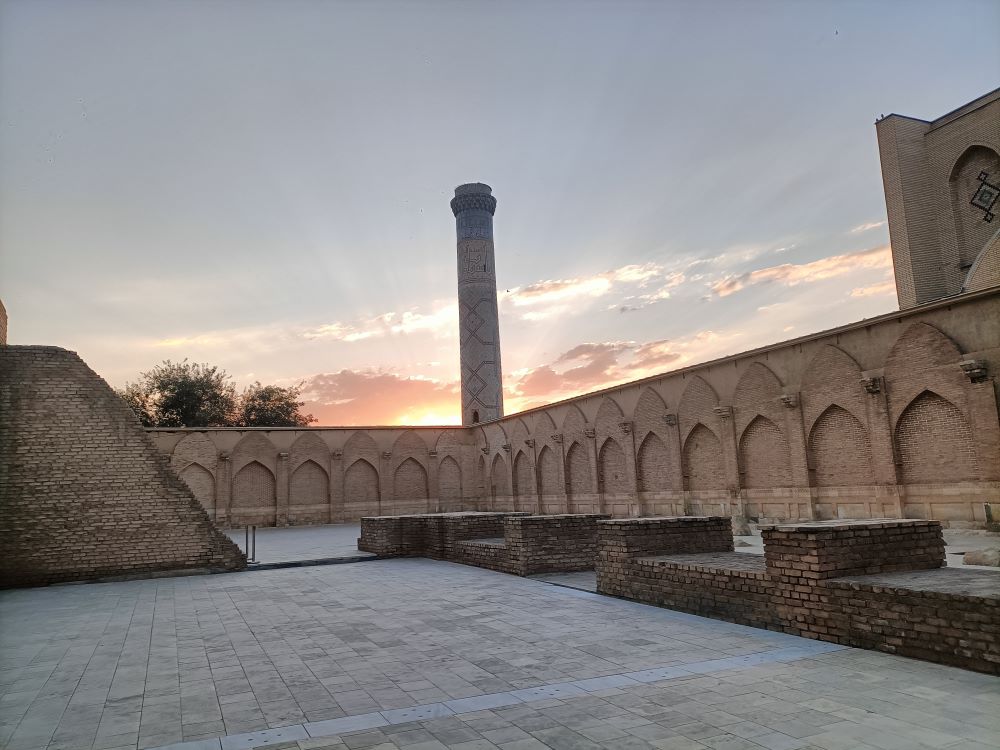
Shop till you Drop at Siyob Bazaar
The Siyob Bazaar is a local food market like the one in Chorsu Bazaar, Tashkent. It mainly sells bread, meat, fruits and dry fruits. The candy, fruit, and nut vendors will call out to you from their stalls, offering to taste their goods. Be sure to try the pistachio halva, it’s a sweet, chewy nougat that is absolutely delicious. But be sure to bargain.
The streets around Siyob Bazaar have been converted into souvenirs shops selling all sorts of memorabilia such ceramics, knives, purses, jewelry, ikkat shrugs, etc. as meant for locals, but there are a few things here to satisfy tourists as well. If you enjoy wandering through markets and enjoying the people watching, you’ll definitely get your fill of that here.
Entrance Fees to Siyob Bazaar: Free
Siyob Bazaar Timings: 9 am – 7 pm
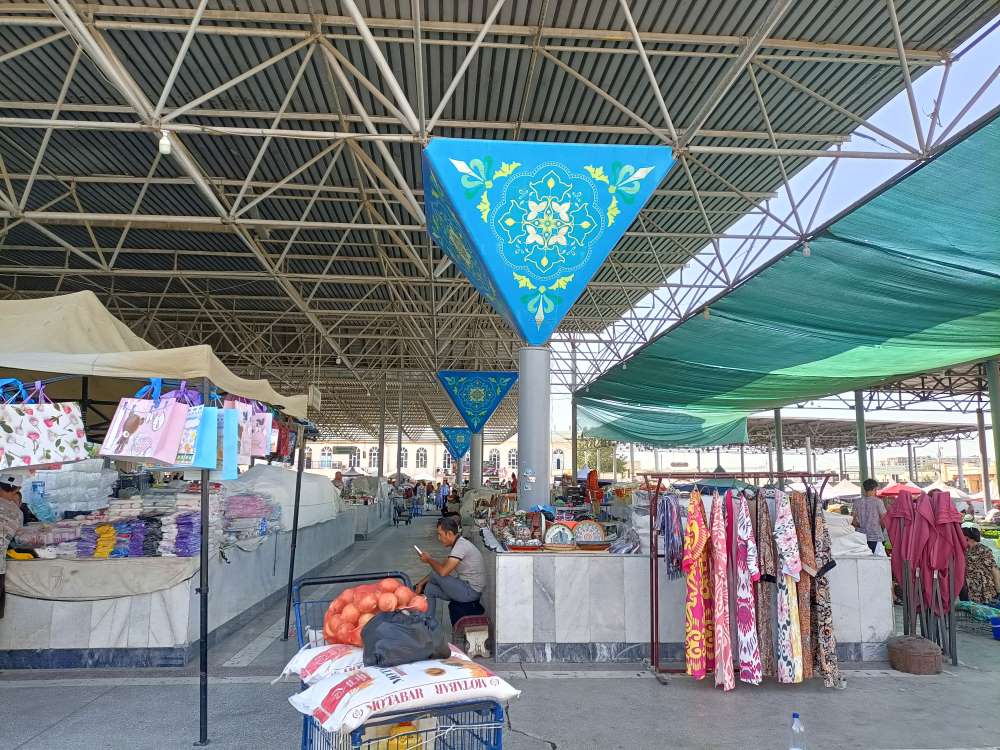
Fall in love with the lanes of Shah-i-Zinda, Samarkand
One of the best things to do in Samarkand is walking the lanes of Shah-i-Zinda.
Shah-i-Zinda is a mausoleum with stunning works of art. It is a necropolis that consists of rows of blue tombs and various mausoleums grouped along a narrow avenue. The vibrant blue tilework is prevalent throughout the complex, making it a photographer’s dream!
The name Shah-i-Zinda translates to “Tomb of the Living King” which refers to the holiest of the shrines, which is likely the grave of Qusam ibn-Abbas. He is famed for bringing Islam to this region in the 7th century. The mausoleums here were built over the periods of the 11th to the 19th centuries as Timur and Ulugbek buried their families and closest confidants here at later dates.
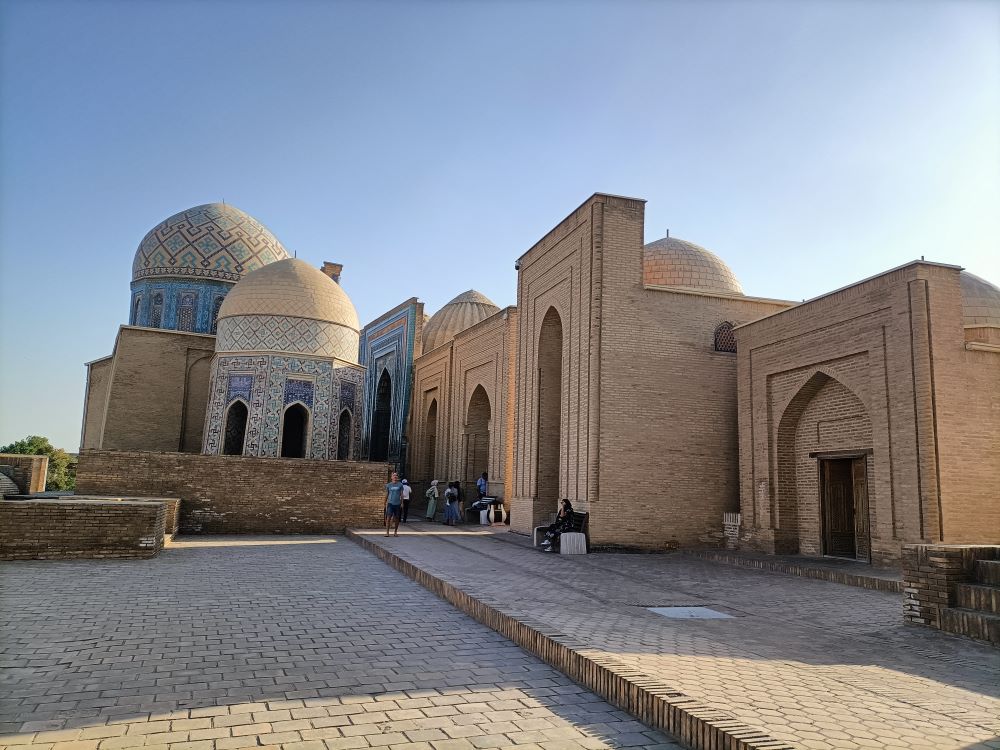
There exist multiple guidelines for visitors at the Shah-i-Zinda Mausoleum. These include dressing modestly as a sign of reverence for the deceased. Furthermore, it’s prohibited to take photos near the tombstones, sit on them, speak loudly, exhibit improper behavior, place money on graves, or conduct animal sacrifices at the gravesites.
Shah-i-Zinda entry fees: 50,000 UZS ($4)
Timings of Shah-I-Zinda: Open daily from 7 am until 7 pm
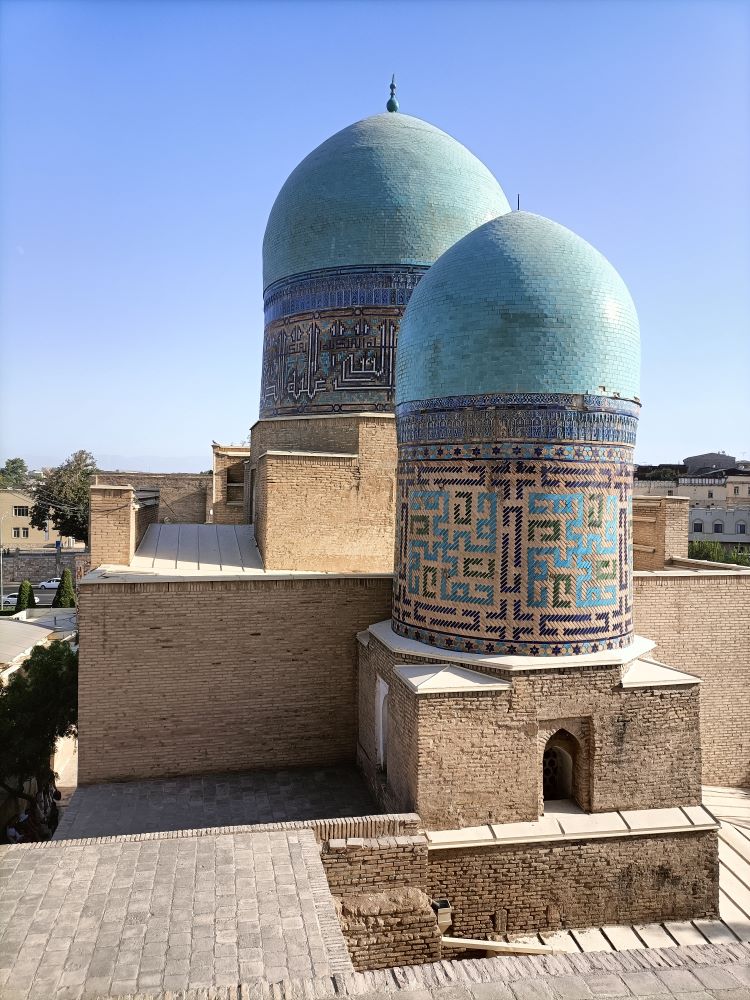
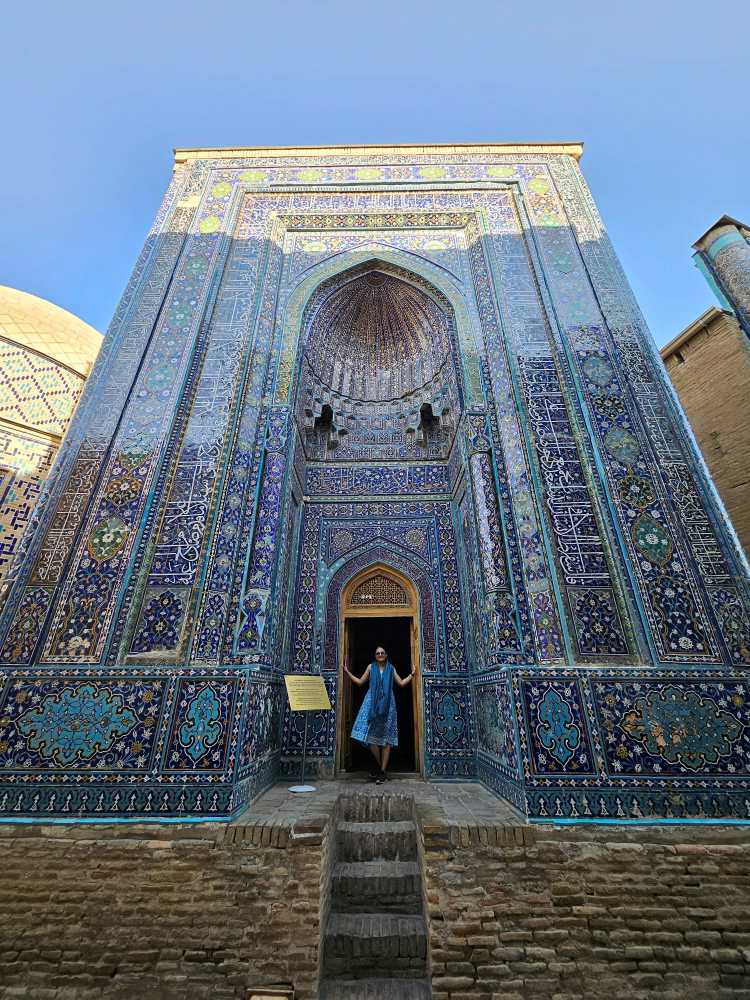
Get lost in the Gur-e-Amir Complex
The Gur-e-Amir Complex is a striking madrasah that houses the tombs of Amir Temur and his beloved descendants. Which is why visiting it is one of most popular things to do in Samarkand.
The building was originally meant to be an Islamic school at the direction of Temur’s grandson, Muhammad Sultan. But after he died suddenly in 1403, Temur ordered that the complex be changed to a mausoleum. Temur was originally meant to be buried in his hometown of Shakhrisabz, but his body was laid to rest at the Gur-e Amir, as well as his other infamous grandson Ulugbek.
The outer embellishment of the mausoleum showcases a combination of blue, turquoise, and white tiles arranged in geometrical and epigraphic patterns, set against a backdrop of terracotta bricks.
The interior of the mausoleum is truly breathtaking! Geometric panels dazzle with star-shaped motifs, while niches adorned with papier-mâché stalactites painted in hues of blue and gold add to its splendor.
Amir Temur’s jade stone grave is in the center of the grandiose room that houses all of the tombs. Outside is a lovely courtyard and garden, with a spectacular arched gate at the entryway.
Gur-e-amir entrance Fees: 50,000 UZS ($4)
Timings of Gur-e-amir: The Gur-e-Amir mausoleum is open daily from April to October from 8.00 am until 7.00 pm and from November to March from 9.00 am until 5.00 pm.
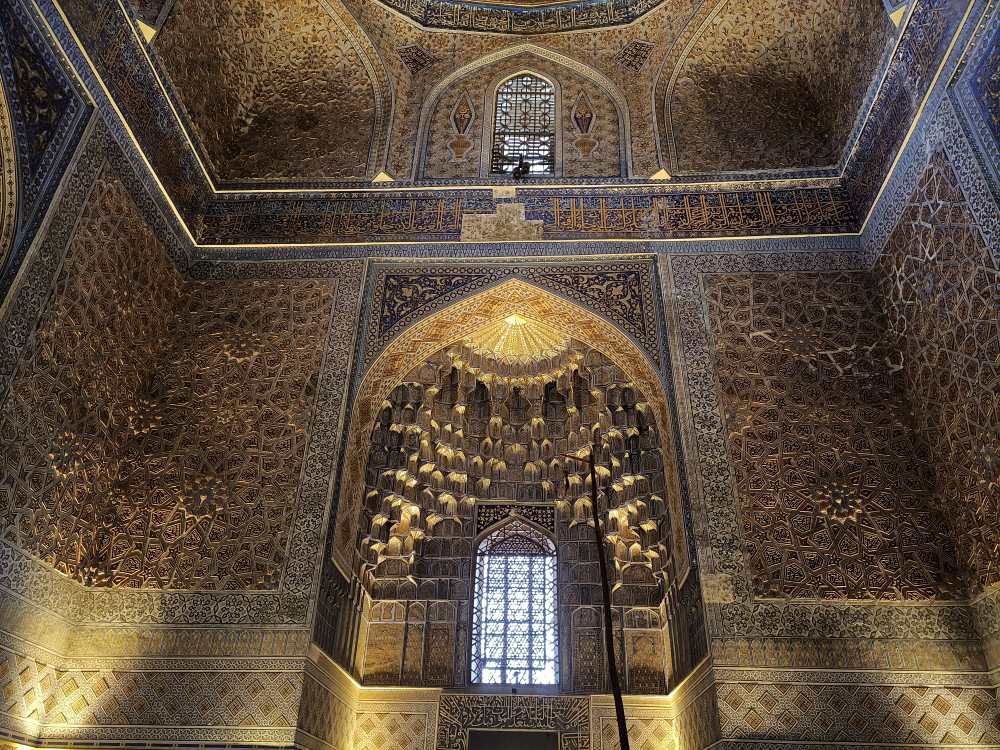
Learn about astronomy at the Ulugh Beg Observatory
One of the most popular things to do in Samarkand is visiting the Ulugh Beg Observatory.
The observatory comprises a three-story cylindrical structure enclosing three massive astronomical instruments. Among these, the primary instrument is a towering meridian arc, reaching a monumental height of 40 meters, employed for measuring the elevation angles of celestial bodies.
Initially erected in 1428-1429 by the renowned astronomer Ulugh Beg, the Ulugh Beg Observatory stood as one of the prominent observatories in the Islamic world at that time. Tragically, it fell victim to destruction in 1449 at the hands of religious extremists, remaining lost for many years until its rediscovery in 1908.
Within its walls, remarkable discoveries were made. Ulugh Beg’s calculations revealed that the duration of a stellar year approximated 365 days, 6 hours, 10 minutes, and 8 seconds, an accuracy only slightly deviating from modern calculations by less than a minute.
Today, the only remnants of the observatory consist of the sextant, an instrument utilized for determining midday, sheltered under a protective roof. Peering down into the sizable aperture, visitors can catch a glimpse of the substantial section below.
Adjacent to it, stands a modest museum offering insights into Ulugh Beg’s legacy and the groundbreaking astronomical work conducted within the observatory during the 15th century.
Ulugh Beg Observatory Entrance fees: 50,000 UZS ($4)
Timings of Ulugh Beg Observatory: Open daily from 9 am until 7 pm.
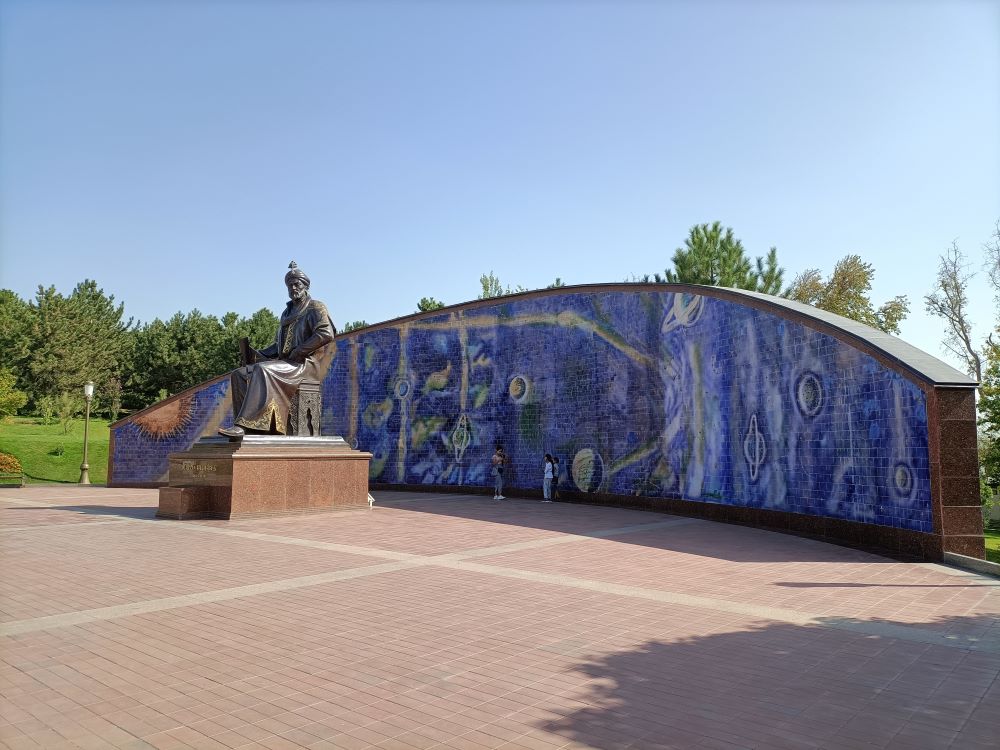
Visit the President’s Tomb
The President’s Tomb provides a convenient stop on your return journey from the Ulugh Beg Observatory. Here, you can marvel at both the Hazrati Khizr Mosque and the final resting place of the former president.
Islam Karimov, the former president of Uzbekistan, governed the Uzbek SSR in 1990 before proclaiming Uzbekistan’s independence on September 1, 1991. Following this, he secured a landslide victory in the inaugural general election held in December of the same year. Karimov continued to win subsequent re-elections by a significant margin, often surpassing 90% of the vote, until his passing in 2016.
Similar to other historic and religious landmarks in Samarkand, the mosque and adjoining tomb showcase breathtaking architecture and rich historical significance. Visitors may have the opportunity to ascend the minaret upon payment of the entrance fee, affording panoramic views of the courtyard below. While photography is permitted in this area, capturing images of the actual president’s tomb is prohibited.
President’s Tomb entry fees: 20,000 ($1.60)
Timings of President’s Tomb, Samarkand: Open daily from 9 am until 7 pm
PLACES TO VISIT NEAR SAMARKAND
Shakhrisabz
Shakhrisabz is 85 km away from Samarkand and a perfect one day trip. Shakhrisabz is an important city in the history of Uzbekistan as Amir Temur was born in the neighboring village of Hodja-Ilgar and made Shakhrisabz his residence. Today it is a UNESCO World Heritage Site and has several interesting architectural sites to explore.
The drive from Samarkand to Shakhrisabz crosses the Aman-Kutan Gorge and Takhta-Karacha Mountain Pass. On the way, tourists can make a stop to take a view at Teshiktosh (Stone with hole). The film “Apachen” (1973) was shot on this location – an area that looks incredibly like the American Southwest.
Drive to Shakhrisabz and exploring various places would take about 3 hours. The tour will cover the Mausoleum of Jakhongir in Dor-us Saodat Memorial Complex, the remains of Ak Saray Palace and Kok Gumbaz Mosque.
Entry fees for each of these places varies between 10,000 – 15,000 UZS ($0.8-1.2). The car rental would be extra depending upon the car you choose.
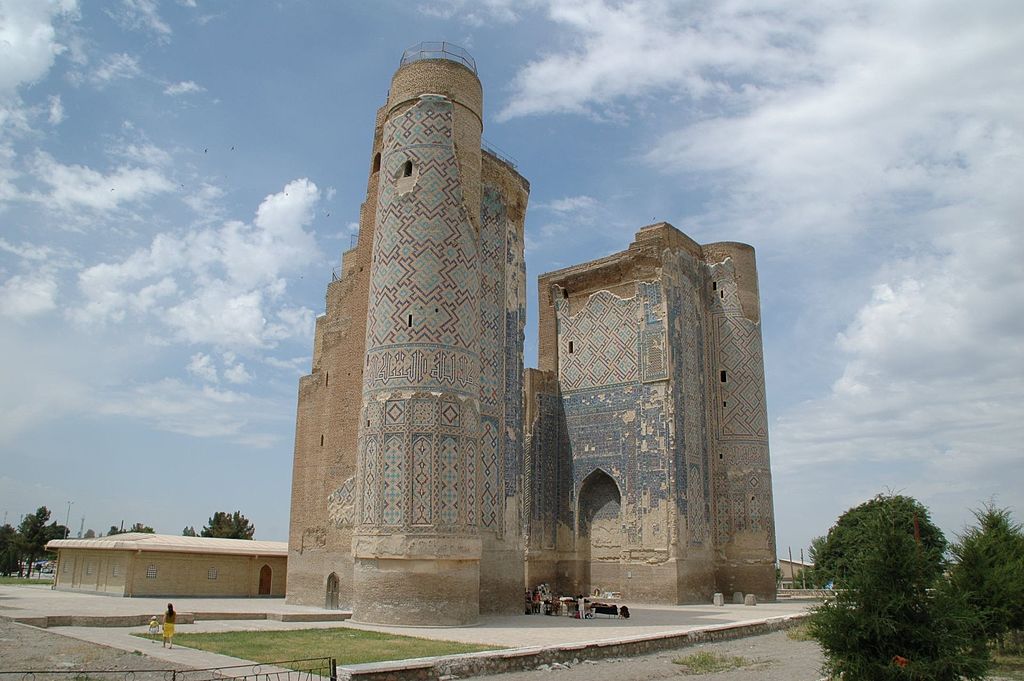
FAQs FOR THINGS TO DO IN SAMARKAND
Is a guide required for Samarkand sightseeing?
Samarkand is full of UNESCO World Heritage sites, and one can understand the history well if there is a guide with you. Although tourists can hire local guides at each tourist destination who offer services in many languages, I suggest that having a guide on the entire trip is beneficial as one can visit some offbeat spots. That being said, I hired a guide only for Registan Square and paid 1,00,000 UZS ($8) and it was worth it!
Is Samarkand safe?
Yes! Samarkand is a very safe city, even if you’re traveling as a woman by yourself. I found women drivers in app based taxis late at night and that was cherry on the cake!
The Uzbeks are very friendly and have no bad intentions whatsoever. Be prepared to take loads of photos with locals. Being an Indian, they wanted to strike a conversation with me with the few Hindi words they knew. They are huge Bollywood fans and know many actors’ names.
Best time to visit Samarkand?
Samarkand can be visited all year round but I’d say that early autumn (September and October) and spring (April and May) would be the best time to visit the city.
Summers (June till August) are usually very hot in Uzbekistan. I went in August end and the afternoons were too hot and I am someone who lives in India. It was too much for me as well and I did not venture out between 2-4pm.
Winters (December till February) are also a good time if you want to avoid the crowds. If you’re lucky, you might get to see the stunning architecture coated in snow.
How many days to spend in Samarkand?
2 full days are enough to cover the highlights and the offbeat places in Samarkand.
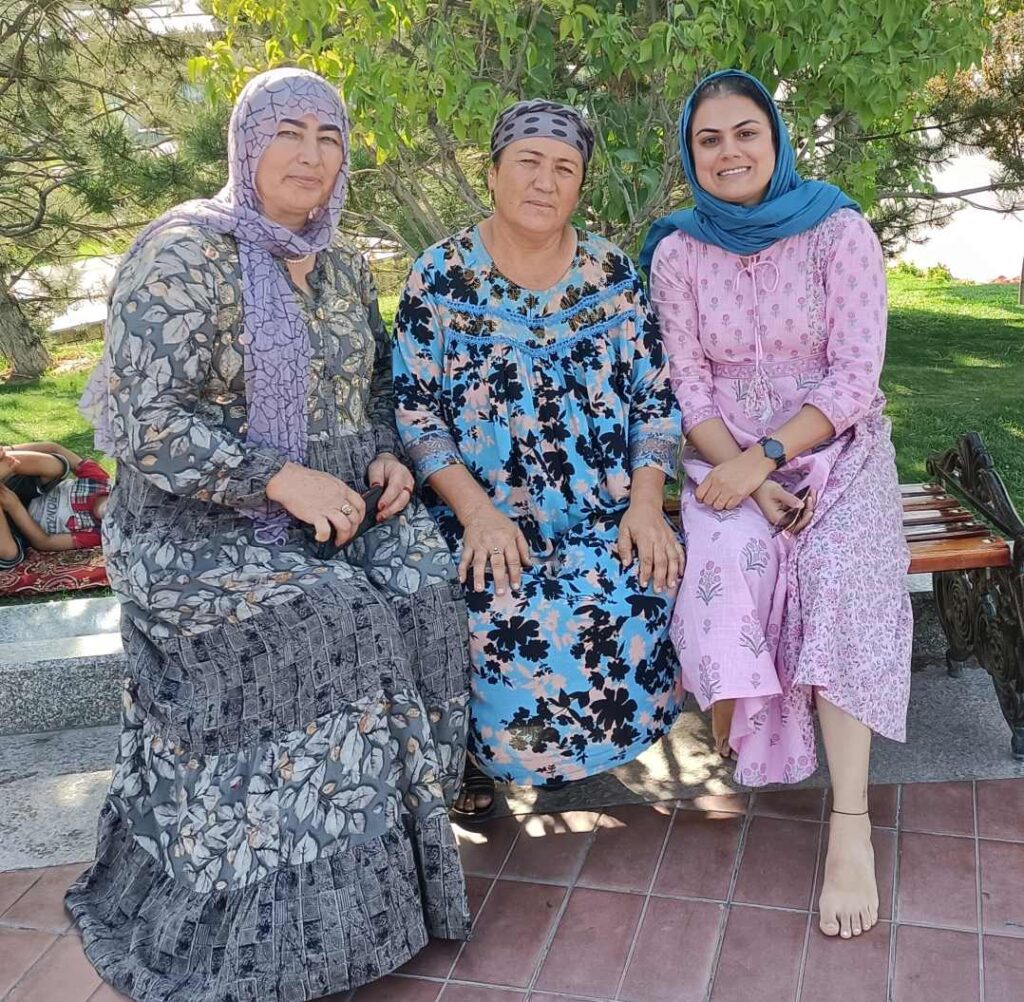
SUSTAINABLE TIPS FOR THINGS TO DO IN SAMARKAND
- Carry your own refillable water bottle. Avoid purchasing PET water bottles unless absolutely necessary.
- Do not trash the heritage site with wrappers and uneaten food. Use designated areas and right-colored bins for disposing of waste.
- Be mindful of all the signs and follow them respectfully especially in mosques and mausoleums.
- Respect the ancient structures of mosques and other structures by not sitting on them.
- Respect the places which prohibit photography.
- Do not write on the pillars and walls of archeological sites and monuments.
I hope this 3 days Samarkand guide helps you plan all things to do in Samarkand. Do you have more questions? Write to me in the comment below and I will reply.
Looking for more Uzbekistan Inspiration? Read Here
- Things to do in Bukhara
- Uzbekistan Travel Guide
- Tashkent Metro Stations
- Tashkent Attractions
- Souvenirs to buy from Uzbekistan
- Things to do in Khiva
- Travelling by train in Uzbekistan
Disclaimer: This post contains affiliate links. It means it adds no extra cost to you if you book through the link but I get a referral bonus which helps me earn a little to keep this website up and running.
PIN THIS POST!
